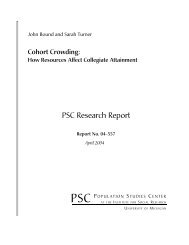Population Ageing and the Well-Being of Older Persons in Thailand ...
Population Ageing and the Well-Being of Older Persons in Thailand ...
Population Ageing and the Well-Being of Older Persons in Thailand ...
Create successful ePaper yourself
Turn your PDF publications into a flip-book with our unique Google optimized e-Paper software.
Endnotes<br />
1<br />
On gender <strong>and</strong> age<strong>in</strong>g see Sobieszczyk, Knodel &<br />
Chayovan (2003) which provides a framework for<br />
<strong>in</strong>terpret<strong>in</strong>g gender differences <strong>in</strong>clud<strong>in</strong>g a review<br />
<strong>of</strong> relevant policies <strong>and</strong> laws <strong>and</strong> socio-cultural<br />
sett<strong>in</strong>g. More general framework for exam<strong>in</strong><strong>in</strong>g<br />
gender <strong>and</strong> age<strong>in</strong>g are available <strong>in</strong> Knodel &<br />
Ofstedal (2003) <strong>and</strong> Ofstedal, Reidy & Knodel<br />
(2004). Additional studies specific to Thail<strong>and</strong><br />
<strong>in</strong>clude Knodel (2004) <strong>and</strong> Soonthorndhada<br />
et al. (2008).<br />
2<br />
The 2007 National Survey <strong>of</strong> <strong>Older</strong> <strong>Persons</strong> is a<br />
nationally representative survey <strong>of</strong> persons age 50<br />
<strong>and</strong> older that provides <strong>in</strong>formation for over<br />
30,000 persons age 60 <strong>and</strong> older. For 27 per cent<br />
<strong>of</strong> <strong>the</strong>se persons <strong>in</strong>formation was provided by a<br />
proxy respondent, typically ano<strong>the</strong>r household<br />
member. For convenience, <strong>in</strong> this report we <strong>the</strong><br />
term respondent refers to <strong>the</strong> older person to<br />
whom <strong>the</strong> responses apply even if a proxy<br />
provided <strong>the</strong> <strong>in</strong>formation.<br />
3<br />
The measure should be considered only very<br />
approximate for two reasons. First, persons <strong>in</strong> <strong>the</strong><br />
numerator are not necessarily parents <strong>of</strong> persons<br />
<strong>in</strong> <strong>the</strong> denom<strong>in</strong>ator. Second, age report<strong>in</strong>g at very<br />
old ages is <strong>of</strong>ten <strong>in</strong>accurate <strong>and</strong> typically<br />
exaggerated (Chayovan, Knodel <strong>and</strong> Siriboon<br />
1990). Thus adjustments are required which mean<br />
that <strong>the</strong> ratio is heavily dependent on assumptions<br />
underly<strong>in</strong>g <strong>the</strong> adjustment procedures.<br />
4<br />
Overall respondents age 60 <strong>and</strong> over average just<br />
0.09 step <strong>and</strong> adopted children compared to 3.97<br />
own biological children. Among those with no<br />
biological children <strong>of</strong> <strong>the</strong>ir own, 28 per cent have<br />
at least one step or adopted child compared to<br />
only 7 per cent <strong>of</strong> those with at least one<br />
biological child.<br />
5<br />
The Labour Force Survey provides more details<br />
on educational atta<strong>in</strong>ment than <strong>the</strong> 2007 Survey<br />
<strong>of</strong> <strong>Older</strong> <strong>Persons</strong> permitt<strong>in</strong>g form<strong>in</strong>g more appro<br />
priate categories for our purposes.<br />
6<br />
In NSO surveys, work refers to employment, work<br />
for pay or pr<strong>of</strong>it, <strong>and</strong> work as an unpaid family<br />
worker but excludes domestic chores with<strong>in</strong> <strong>the</strong><br />
household. S<strong>in</strong>ce some types <strong>of</strong> work are seasonal,<br />
estimates <strong>of</strong> economic activity dur<strong>in</strong>g <strong>the</strong><br />
previous week will exclude some persons who work<br />
at o<strong>the</strong>r times <strong>of</strong> <strong>the</strong> year but are <strong>in</strong>active at <strong>the</strong><br />
time <strong>of</strong> <strong>the</strong> survey.<br />
7<br />
For example, 84 per cent <strong>of</strong> rural older persons or<br />
<strong>the</strong>ir spouse own <strong>the</strong>ir home compared to only<br />
70 per cent <strong>of</strong> urban older persons.<br />
8<br />
See (Knodel, Chamratrithirong & Debavalya<br />
1987, p.158) for references to a series <strong>of</strong> studies<br />
document<strong>in</strong>g <strong>the</strong> role <strong>of</strong> wives <strong>and</strong> husb<strong>and</strong>s<br />
with<strong>in</strong> <strong>the</strong> family.<br />
9<br />
In 2007, <strong>the</strong> rema<strong>in</strong><strong>in</strong>g 64 per cent <strong>of</strong> respondents<br />
were evenly divided between those who lived <strong>in</strong><br />
wooden dwell<strong>in</strong>gs <strong>and</strong> those who lived <strong>in</strong><br />
dwell<strong>in</strong>gs made <strong>of</strong> both cement <strong>and</strong> wood.<br />
10<br />
The mean number <strong>of</strong> household possessions is<br />
based on <strong>the</strong> items shown <strong>in</strong> table 3.8 except that<br />
mobile phones <strong>and</strong> cell phones, cars <strong>and</strong> trucks,<br />
<strong>and</strong> gas <strong>and</strong> electric stoves are treated as separate<br />
items thus rais<strong>in</strong>g <strong>the</strong> maximum total number <strong>of</strong><br />
possible household possessions to 19.<br />
11<br />
For example, <strong>the</strong> life table shows under 5<br />
mortality for boys to be more than seven times<br />
that for girls, a very unlikely f<strong>in</strong>d<strong>in</strong>g.<br />
70















